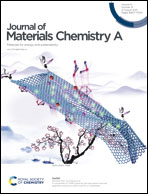Electrochemically-induced structural reconstruction in promoting the Zn storage performance of a CaMn3O6 cathode for superior long-life aqueous Zn-ion batteries†
Abstract
Aqueous zinc-ion batteries (AZIBs) are regarded as alternative and promising large-scale energy storage systems due to their low cost, convenient manufacturing processes, and safety. However, their development has been restricted by the lack of suitable cathode materials. Here, we report an electrochemically-induced structure-reconstructed CaMn3O6@expanded graphite cathode with enhanced Zn storage performance. The restructured cathode exhibits abundant defects and phase interfaces, indicating higher electrochemical reactivity, larger active surface areas, accelerated ion diffusion kinetics, and superior structural robustness. Thus, the restructured cathode shows a high capacity (521.7 mA h g−1 at 0.2 A g−1), outstanding long-term stability (100% capacity retention after 2350 cycles at 2 A g−1, 75% after an additional 17 000 cycles at 5 A g−1), and superior rate performance. Deep and systematic investigation of the electrochemical mechanism using ex situ XRD, XPS, and TEM confirmed the co-insertion of both H+ and Zn2+. This work introduces a convenient and low-cost approach for promoting the Zn storage performance and new insights into the electrochemical mechanism of manganates for AZIBs.



 Please wait while we load your content...
Please wait while we load your content...